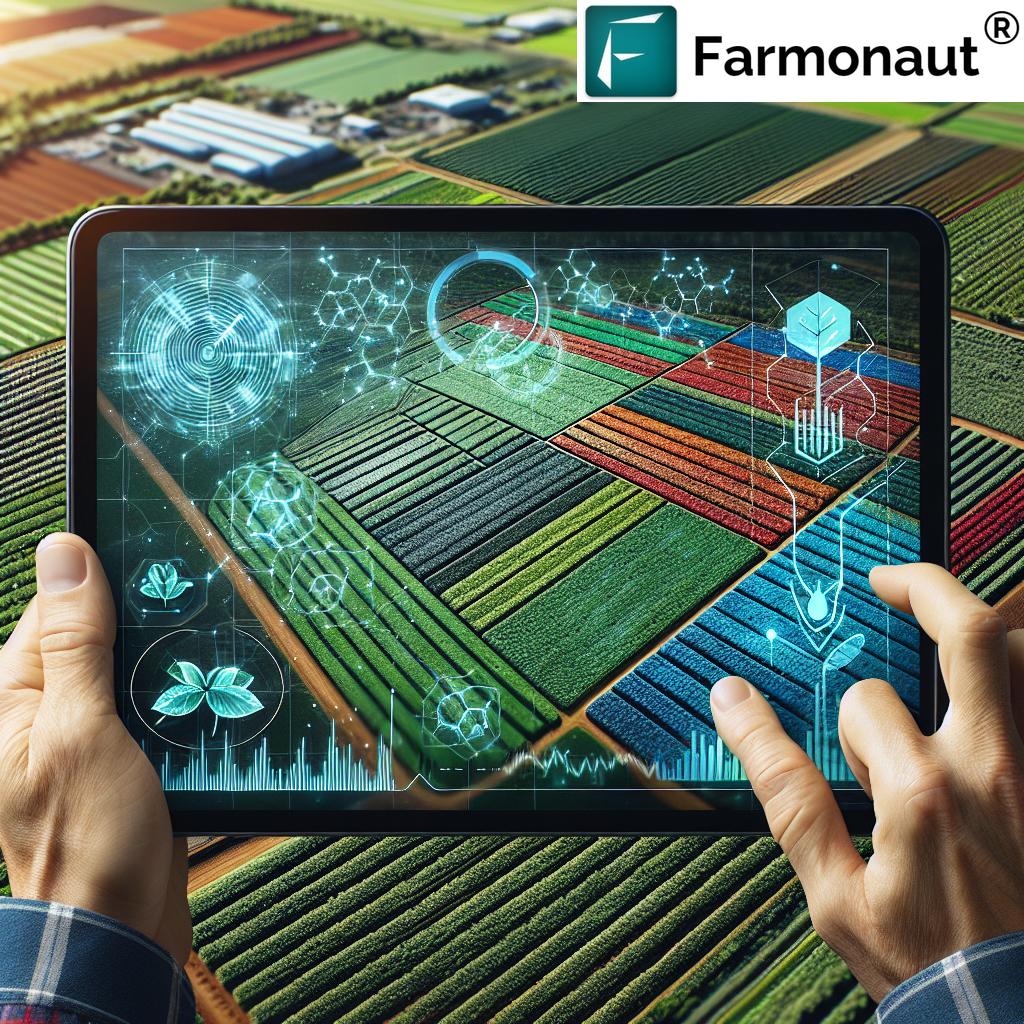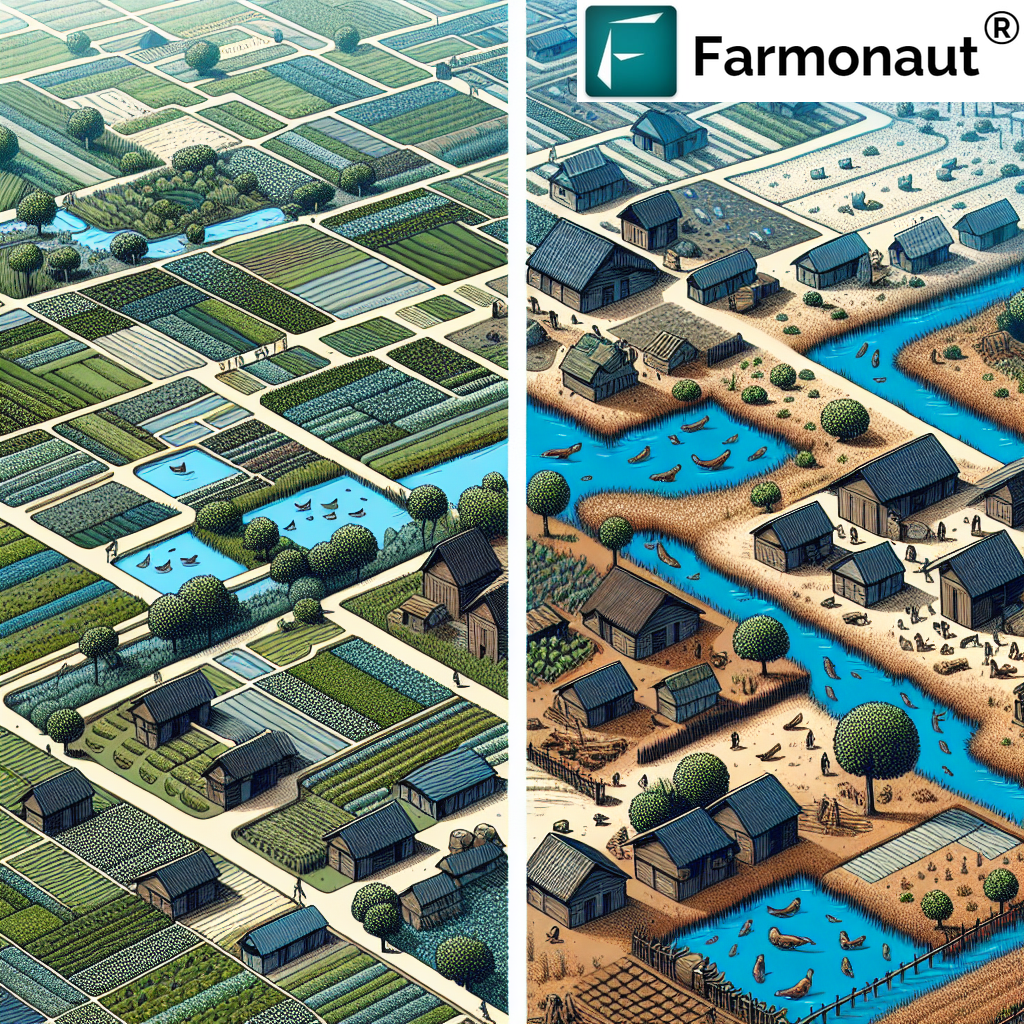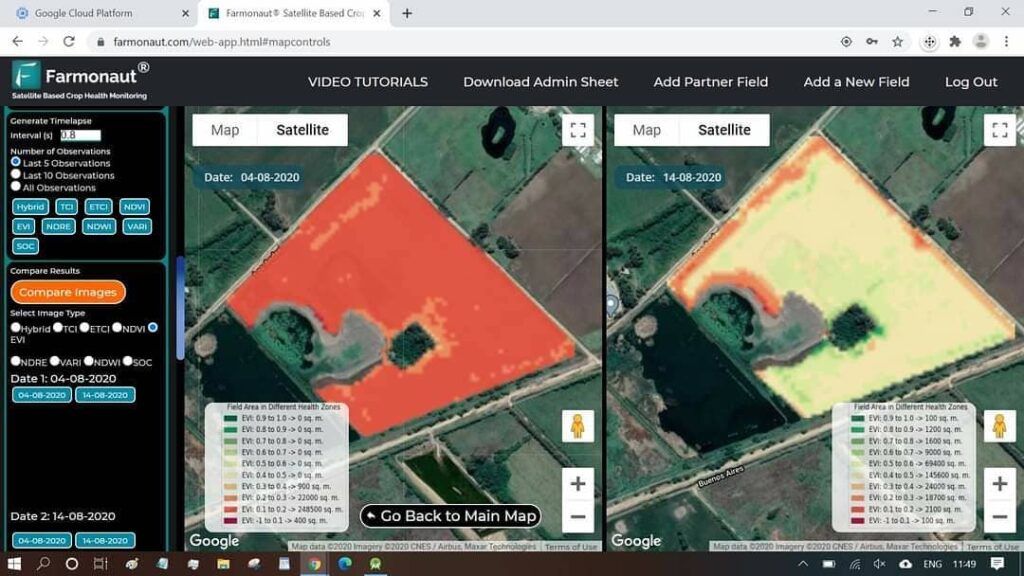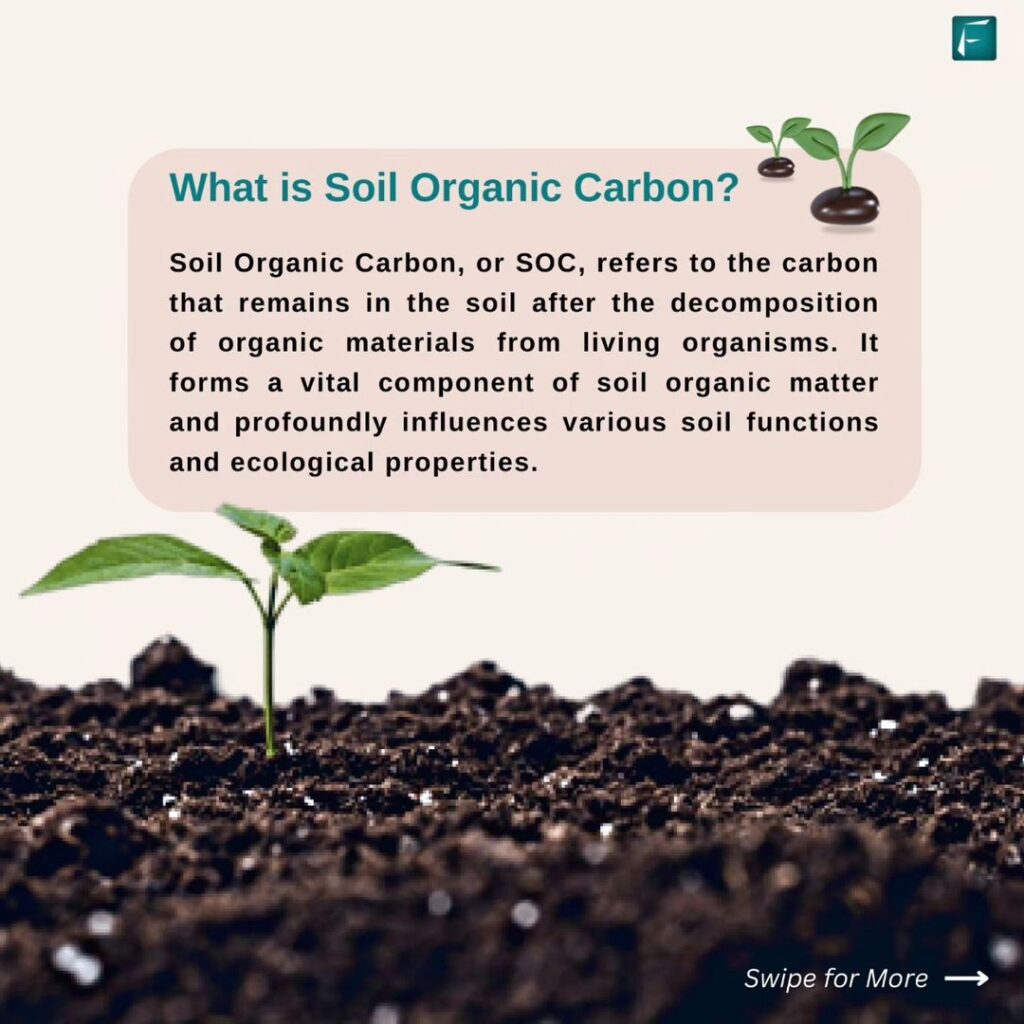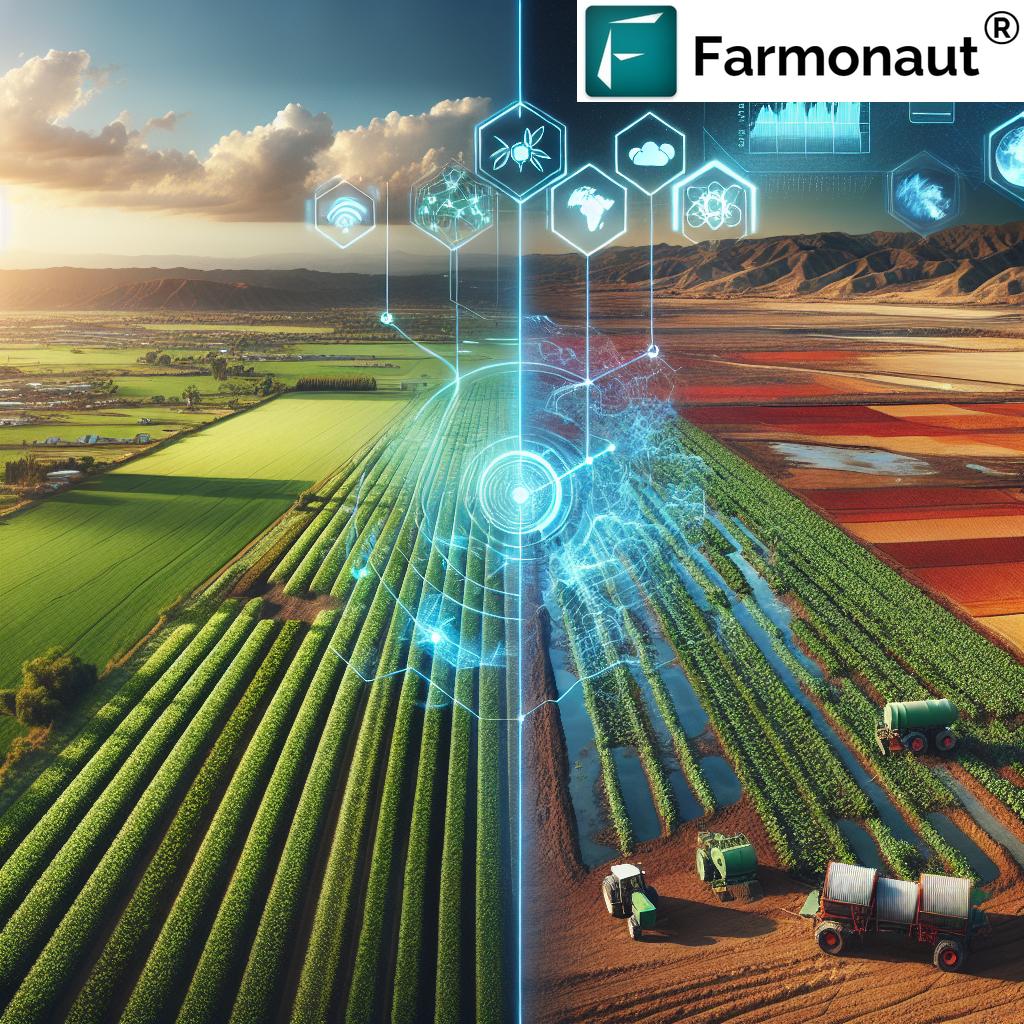
NDVI Explained: What is NDVI Index and How It Revolutionizes Precision Agriculture
In the ever-evolving world of agriculture, precision farming has become a game-changer. At the heart of this revolution lies a powerful tool known as the NDVI index. As experts in agricultural technology at Farmonaut, we’re excited to dive deep into the world of NDVI and explore how it’s transforming the way we approach farming. In this comprehensive guide, we’ll answer the burning question: “What is NDVI?” and demonstrate how this innovative index is reshaping the agricultural landscape.
Table of Contents
- Understanding NDVI: The Basics
- The Science Behind NDVI
- How NDVI Works in Agriculture
- Benefits of Using NDVI in Farming
- NDVI Applications in Precision Agriculture
- Farmonaut’s NDVI Solutions
- Comparing NDVI with Other Vegetation Indices
- Challenges and Limitations of NDVI
- The Future of NDVI in Agriculture
- FAQs about NDVI
1. Understanding NDVI: The Basics
NDVI, or the Normalized Difference Vegetation Index, is a simple yet powerful indicator used to assess the health and vigor of vegetation from satellite imagery. But what exactly is NDVI, and why is it so crucial in modern agriculture?
What is NDVI?
NDVI is a standardized index that allows us to generate an image displaying the greenness – or relative biomass – of vegetation. This index capitalizes on the fact that healthy vegetation reflects more near-infrared (NIR) and green light compared to other wavelengths, but absorbs more red and blue light.
The NDVI index ranges from -1 to +1, where:
- Negative values generally correspond to water
- Values close to zero (-0.1 to 0.1) generally correspond to barren areas of rock, sand, or snow
- Low, positive values (0.2 to 0.4) represent shrub and grassland
- High values (0.6 to 0.8) indicate temperate and tropical rainforests
At Farmonaut, we harness the power of NDVI to provide farmers with invaluable insights into their crops’ health and productivity. Our satellite-based crop health monitoring system uses NDVI as a key metric to help farmers make informed decisions about irrigation, fertilization, and pest management.
2. The Science Behind NDVI
To truly understand the NDVI index, we need to delve into the science that makes it work. NDVI is based on the principle that healthy vegetation absorbs most of the visible light that hits it and reflects a large portion of near-infrared light.
The NDVI Formula
The NDVI is calculated using the following formula:
NDVI = (NIR – RED) / (NIR + RED)
Where:
- NIR = reflection in the near-infrared spectrum
- RED = reflection in the red range of the spectrum
This formula yields a value between -1 and +1, where higher values indicate healthier vegetation.
The Role of Chlorophyll
Chlorophyll, the pigment responsible for photosynthesis in plants, plays a crucial role in NDVI measurements. Chlorophyll strongly absorbs visible light (from 0.4 to 0.7 µm) for use in photosynthesis. The cell structure of leaves, on the other hand, strongly reflects near-infrared light (from 0.7 to 1.1 µm).
As a result, the more leaves a plant has, the more these wavelengths of light are affected. By measuring the intensity of reflected light in these wavelengths, we can assess the density of green vegetation in a specific area.

3. How NDVI Works in Agriculture
In agriculture, NDVI serves as a valuable tool for assessing crop health, predicting yields, and managing resources efficiently. Here’s how it works:
Crop Health Assessment
NDVI values correlate strongly with the health and vigor of vegetation. Higher NDVI values typically indicate healthier, more robust crops. By regularly monitoring NDVI values across their fields, farmers can quickly identify areas where crops may be stressed or underperforming.
Yield Prediction
NDVI data collected over time can be used to predict crop yields. Generally, higher NDVI values during key growth stages correlate with higher potential yields. This information allows farmers to make more accurate yield forecasts and adjust their management practices accordingly.
Resource Management
By providing a clear picture of crop health across entire fields, NDVI helps farmers optimize their use of resources like water and fertilizer. Areas with lower NDVI values may require more attention, while areas with consistently high values may need fewer inputs.
Pest and Disease Detection
Changes in NDVI values can sometimes indicate the presence of pests or diseases before they become visible to the naked eye. This early warning system allows farmers to take preventive action, potentially saving crops and reducing the need for pesticides.
4. Benefits of Using NDVI in Farming
The adoption of NDVI in agriculture brings numerous benefits to farmers and the agricultural industry as a whole. At Farmonaut, we’ve seen firsthand how this technology can transform farming practices:
- Improved Crop Management: NDVI provides farmers with a tool to monitor crop health throughout the growing season, allowing for timely interventions when issues arise.
- Increased Yields: By optimizing resource use and addressing problems early, farmers can significantly increase their crop yields.
- Cost Reduction: Precision application of inputs like water and fertilizer, guided by NDVI data, can lead to substantial cost savings.
- Environmental Benefits: More efficient use of resources means less waste and reduced environmental impact.
- Time Savings: Satellite-based NDVI monitoring can cover large areas quickly, saving farmers time compared to manual field inspections.
- Data-Driven Decision Making: NDVI provides objective, quantifiable data to inform farming decisions, reducing guesswork and improving outcomes.
5. NDVI Applications in Precision Agriculture
The applications of NDVI in precision agriculture are vast and continually expanding. Here are some key ways in which NDVI is being used to revolutionize farming practices:
Variable Rate Application
NDVI maps can guide variable rate application of fertilizers and other inputs. Areas with lower NDVI values may require more nutrients, while high NDVI areas might need less. This targeted approach optimizes resource use and can lead to significant cost savings.
Irrigation Management
By correlating NDVI data with soil moisture levels, farmers can develop more efficient irrigation strategies. Areas with lower NDVI values might indicate water stress, prompting targeted irrigation.
Crop Rotation Planning
Historical NDVI data can inform crop rotation decisions. Farmers can identify which crops perform best in different areas of their fields and plan rotations accordingly.
Harvest Timing
NDVI trends can help determine optimal harvest times. As crops mature, NDVI values typically decrease. Monitoring this decline can help farmers pinpoint the best time to harvest for maximum yield and quality.
Carbon Sequestration Monitoring
NDVI can be used to estimate biomass, which is crucial for carbon sequestration calculations. This application is becoming increasingly important as agriculture looks to play a role in mitigating climate change.
6. Farmonaut’s NDVI Solutions
At Farmonaut, we’ve developed cutting-edge solutions that leverage NDVI technology to empower farmers. Our satellite-based crop health monitoring system provides regular NDVI updates, allowing farmers to track their crops’ health with unprecedented precision.
Key Features of Farmonaut’s NDVI Solutions:
- High-Resolution Imagery: We use high-resolution satellite imagery to generate accurate NDVI maps.
- Regular Updates: Our system provides frequent NDVI updates, allowing farmers to track changes over time.
- User-Friendly Interface: Our platform presents NDVI data in an easy-to-understand format, accessible via web and mobile apps.
- AI-Powered Insights: Our Jeevn AI advisory system combines NDVI data with other factors to provide personalized recommendations.
- Integration Capabilities: Our NDVI data can be integrated with other farm management tools through our API.
To experience the power of our NDVI solutions, visit
Farmonaut’s application or explore our
API services.
How Farmonaut’s Satellite System Compares to Drone and IoT-based Farm Monitoring
| Feature |
Farmonaut Satellite System |
Drone-based Monitoring |
IoT-based Monitoring |
| Coverage Area |
Large (entire farms) |
Medium |
Limited (point-based) |
| Frequency of Updates |
Regular (every few days) |
On-demand |
Continuous |
| Initial Setup Cost |
Low |
High |
Medium to High |
| Operational Complexity |
Low |
High |
Medium |
| Weather Dependency |
Low |
High |
Low |
| Data Processing Time |
Fast |
Medium |
Fast |
| Scalability |
High |
Medium |
Low to Medium |
7. Comparing NDVI with Other Vegetation Indices
While NDVI is one of the most widely used vegetation indices, it’s not the only one. Let’s compare NDVI with some other popular indices:
Enhanced Vegetation Index (EVI)
EVI is designed to enhance the vegetation signal with improved sensitivity in high biomass regions. It incorporates a soil adjustment factor and atmospheric resistance term.
Soil Adjusted Vegetation Index (SAVI)
SAVI is similar to NDVI but includes a soil brightness correction factor. It’s particularly useful in areas with sparse vegetation where soil surface may be visible.
Normalized Difference Water Index (NDWI)
NDWI is used to monitor changes in water content of leaves. It uses near-infrared (NIR) and short-wave infrared (SWIR) wavelengths.
While these indices have their specific uses, NDVI remains the most widely used due to its simplicity, effectiveness, and long history of application in remote sensing.
8. Challenges and Limitations of NDVI
While NDVI is a powerful tool, it’s important to understand its limitations:
- Saturation: NDVI can saturate in dense vegetation, making it less effective for distinguishing variations in very healthy or dense canopies.
- Atmospheric Effects: Clouds, aerosols, and other atmospheric conditions can affect NDVI readings.
- Soil Background: In areas with sparse vegetation, soil reflectance can influence NDVI values.
- Species Differences: Different plant species may have different NDVI responses, making comparisons across diverse vegetation types challenging.
- Temporal Resolution: The frequency of NDVI data updates depends on satellite revisit times, which may not be sufficient for some applications.
At Farmonaut, we’re continuously working to address these limitations through advanced data processing techniques and integration with other data sources.
9. The Future of NDVI in Agriculture
The future of NDVI in agriculture looks promising, with several exciting developments on the horizon:
Integration with AI and Machine Learning
AI and machine learning algorithms are being developed to analyze NDVI data more effectively, providing even more accurate predictions and recommendations.
Hyperspectral Imaging
Advancements in satellite technology are enabling hyperspectral imaging, which can provide more detailed vegetation indices than traditional NDVI.
Combination with IoT and Ground Sensors
Integrating NDVI with ground-based IoT sensors can provide a more comprehensive picture of crop health and field conditions.
Improved Temporal Resolution
The launch of more satellites and the use of drone technology are improving the frequency of NDVI data updates.
Climate Change Monitoring
NDVI is becoming an important tool in monitoring and understanding the impacts of climate change on vegetation patterns globally.
At Farmonaut, we’re at the forefront of these developments, constantly innovating to bring the latest NDVI technologies to our users.
10. FAQs about NDVI
Q: What does NDVI stand for?
A: NDVI stands for Normalized Difference Vegetation Index.
Q: How often should I monitor NDVI in my fields?
A: The frequency of NDVI monitoring depends on your specific needs and crop types. Generally, monitoring every 5-10 days during the growing season is beneficial.
Q: Can NDVI detect crop diseases?
A: While NDVI can’t directly detect specific diseases, it can indicate areas of stress in crops which may be caused by diseases, pests, or other factors.
Q: Is NDVI effective for all crop types?
A: NDVI is effective for most crop types, but its sensitivity can vary. It’s particularly useful for broad-leaf crops but may be less sensitive for some narrow-leaf crops.
Q: How accurate is NDVI in predicting crop yields?
A: NDVI can provide good estimates of potential yields, especially when combined with other data sources. However, final yields can be influenced by many factors beyond what NDVI measures.
Q: Can I use NDVI for small farms?
A: Yes, NDVI can be useful for farms of all sizes. At Farmonaut, we offer solutions tailored for both small and large farms.
Conclusion
The NDVI index has revolutionized precision agriculture, providing farmers with a powerful tool to monitor crop health, optimize resource use, and increase yields. As we’ve explored in this comprehensive guide, NDVI offers numerous benefits and applications in modern farming.
At Farmonaut, we’re committed to making this technology accessible to farmers of all scales. Our satellite-based crop health monitoring system, powered by advanced NDVI analysis, is helping farmers around the world make more informed decisions and achieve better results.
Ready to experience the power of NDVI for yourself? Try Farmonaut today:
Join us in harnessing the power of NDVI to transform agriculture and build a more sustainable future for farming.





